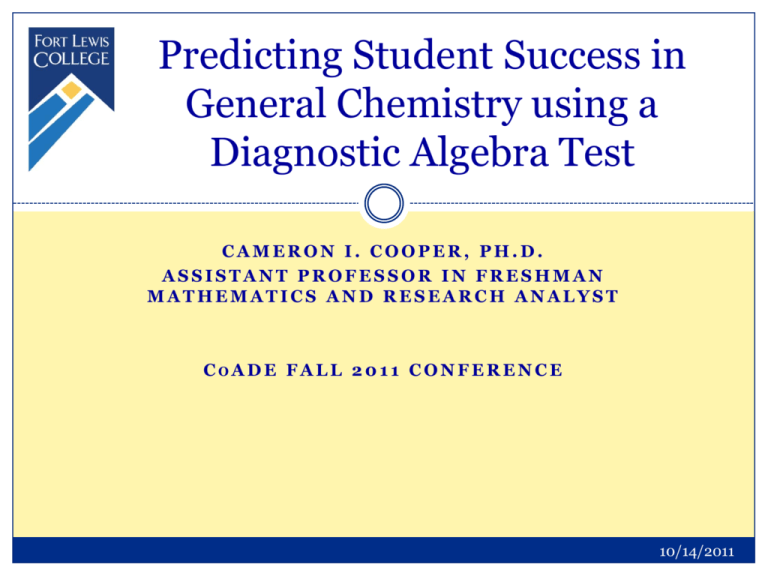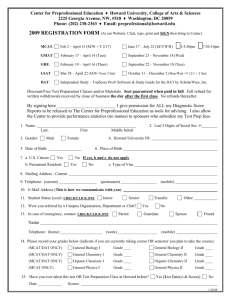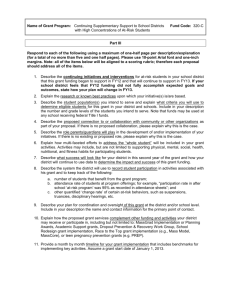Predicting Student Success in General Chemistry Using a
advertisement

Predicting Student Success in General Chemistry using a Diagnostic Algebra Test CAMERON I. COOPER, PH.D. ASSISTANT PROFESSOR IN FRESHMAN MATHEMATICS AND RESEARCH ANALYST COADE FALL 2011 CONFERENCE 10/14/2011 Goals of Research 1. Create a Diagnostic Algebra Test (DAT) subject specific to General Chemistry 2. Create a predictive system to use student scores from DAT to identify “at-risk” students 3. Given results, propose some remediation measures to mitigate students’ “at-risk” classification. 10/14/2011 Good Morning! 10/14/2011 Authoring the DAT Approached all Chemistry professors at Fort Lewis College to identify algebra related topics and questions often asked of students in General Chemistry. 2. Create categorization of questions (i.e. specific mathematical topics being addressed). 3. In collaboration with Chemistry, identify the topics/questions which are presumed knowledge of students. 4. Authored a series of algebra questions with a chemistry-based perspective. 1. 10/14/2011 Question Categorization (Topics) 1. 2. 3. 4. 5. 6. 7. Basic arithmetic and fractions Linear equations, slopes, and graphs Unit conversion, the metric system, and significant digits Scientific notation and powers of 10 Percentages in the context of chemistry Exponent rules and fractional exponents Evaluating and solving formulas in the context of chemistry. 10/14/2011 Final DAT – Question Breakdown 20 questions – 20 minute test – no calculator Topic DAT Questions 1. Basic arithmetic and fractions Questions 1 – 4 2. Linear equations, slopes, and graphs Questions 5 – 7 3. Unit conversion, the metric system, and significant digits 4. Scientific notation and powers of 10 Questions 8 – 11 5. Percentages in the context of chemistry Questions 15 and 16 6. Exponent rules and fractional exponents Questions 17 and 18 7. Evaluating and solving formulas in the context of chemistry. Questions 19 and 20 Questions 12 – 14 10/14/2011 DAT Answers Question Answer % Correct Question Answer % Correct 1 C 92.7 11 B 35.2 2 A 88.3 12 A 57.0 3 D 93.9 13 C 73.2 4 B 70.9 14 B 88.8 5 C 85.5 15 D 71.5 6 A 87.7 16 B 57.0 7 B 76.5 17 D 70.1 8 A 93.9 18 C 70.4 9 C 90.5 19 D 22.9 10 D 40 20 A 51.4 10/14/2011 DAT Results for Fall 2010 (N=187) 10/14/2011 Key Identifiers for “at-risk” students Predictor 1. Declared White 2. Math ACT 3. Cumulative GPA 4. Question 3 on the DAT 5. Question 4 on the DAT 6. Question 5 on the DAT 7. Question 7 on the DAT 8. Question 14 on the DAT 9. Total score on the DAT Spearman’s Rho 0.200** 0.167* 0.173* 0.155* 0.217** 0.202** 0.186* 0.214** 0.186* ** Correlation is significant at the 0.01 level (2-tailed). * Correlation is significant at the 0.05 level (2-tailed). 10/14/2011 Student Data Neural Network 10/14/2011 Predictive System Accuracy Neural network Output: Predicted to be at-risk At-risk students (C- or below) 34 Not at-risk students (C or above) 11 21 121 Predicted not to be at-risk Categorical Accuracies: All students Predicted to be at-risk 45 Predicted not to be at-risk 142 Accuracy of prediction Error of prediction 34 76% 45 11 24% 45 121 85% 142 15 15% 142 10/14/2011 Overall Accuracy At-risk students Not at-risk students All students 76% 85% 83% 10/14/2011 Possible Treatments Predictor Possible Treatment Additional support/funding for the Native American Center (NAC) on campus. Declared White Recruitment and training of well-qualified tutors for the center. Math ACT Raise college admission standards. A concurrent support class that covers basic college study skills (e.g. note taking, Cum GPA time management, and motivation). Q3 Q4 These items are all mathematical topics as a subset of one of the math concepts Q5 listed within the Background section of this paper. A concurrent support course Q7 could possibly cover these topics in a “just-in-time” fashion via the coordination Q14 with the chemistry professors. DAT Score (out of 20) 10/14/2011 Questions? 8/26/2011





